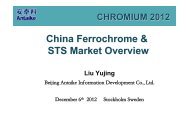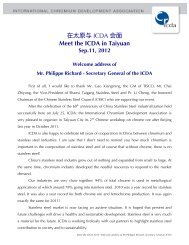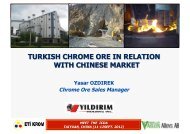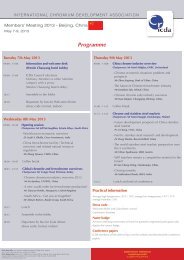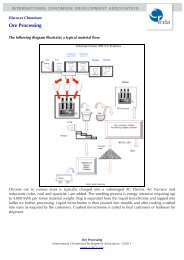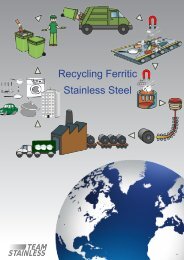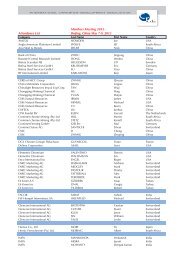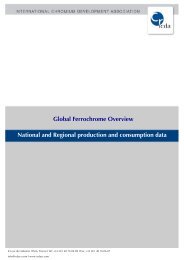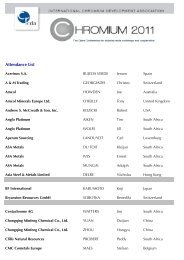icda-chromium-2012-t..
icda-chromium-2012-t..
icda-chromium-2012-t..
You also want an ePaper? Increase the reach of your titles
YUMPU automatically turns print PDFs into web optimized ePapers that Google loves.
Determinants of chrome ore and<br />
stainless steel demand in emerging<br />
markets<br />
Thomas Höhne-Sparborth<br />
Senior Economic Analyst<br />
Roskill Information Services Ltd.<br />
6 th December <strong>2012</strong><br />
Roskill<br />
Approachable. Independent. Expert.
Disclaimer<br />
The statements in this presentation represent the considered views of Roskill<br />
Information Services Ltd. It includes certain statements that may be deemed<br />
"forward-looking statements“. All statements in this presentation, other than<br />
statements of historical facts, that address future market developments, government<br />
actions and events, are forward-looking statements. Although Roskill Information<br />
Services Ltd. believes the outcomes expressed in such forward-looking statements<br />
are based on reasonable assumptions, such statements are not guarantees of future<br />
performance and actual results or developments may differ materially from those in<br />
forward-looking statements. Factors that could cause actual results to differ<br />
materially from those in forward-looking statements include changes in general<br />
economic, market or business conditions.<br />
While Roskill Information Services Ltd. has made every reasonable effort to ensure<br />
the veracity of the information presented it cannot expressly guarantee the accuracy<br />
and reliability of the estimates, forecasts and conclusions contained herein.<br />
Accordingly, the statements in the presentation should be used for general guidance<br />
only.<br />
Roskill<br />
Approachable. Independent. Expert.
Outline<br />
Fundamentals of chrome ore consumption<br />
Historical trends of stainless steel, ferrochrome and chrome ore<br />
Predicting commodity use in emerging markets<br />
<br />
<br />
Intensity of use<br />
Underlying determinants<br />
<br />
Indirect trade<br />
Application to prediction of chrome ore consumption<br />
<br />
<br />
<br />
Regional shifts<br />
Substitution trends<br />
China forecasts<br />
Roskill<br />
Approachable. Independent. Expert.
Fundamentals of chrome ore<br />
consumption<br />
Roskill<br />
Approachable. Independent. Expert.
Relationship between crude steel, stainless steel<br />
and chrome ore<br />
160<br />
Relative movements in consumption of steel and chrome ore<br />
(2005 = 100)<br />
140<br />
120<br />
100<br />
80<br />
60<br />
40<br />
Crude<br />
Stainless<br />
Chrome ore<br />
20<br />
0<br />
1997 1998 1999 2000 2001 2002 2003 2004 2005 2006 2007 2008 2009 2010 2011<br />
Sources: Roskill, SMR, Accenture Research, Baosteel, WSA<br />
Roskill<br />
Approachable. Independent. Expert.
No 1:1 relationship between linked commodities<br />
Multiple end products<br />
Different roles in industrialisation<br />
Role of upstream and downstream substitutes<br />
Technological change in production processes<br />
Effects of regional shifts in production<br />
Short-term effects of stockpiles<br />
Roskill<br />
Approachable. Independent. Expert.
Predicting commodity use in<br />
emerging markets<br />
Roskill<br />
Approachable. Independent. Expert.
Country experiences seem widely divergent<br />
1 400<br />
Comparative use of steel (kg crude steel per capita)<br />
1 200<br />
1 000<br />
800<br />
600<br />
400<br />
200<br />
0<br />
0 5 000 10 000 15 000 20 000 25 000 30 000 35 000 40 000 45 000<br />
GDP per capita (US$2000, ppp adjusted)<br />
Sources: Roskill, USGS, US Bureau of Economic Analysis, WSA<br />
Roskill<br />
Approachable. Independent. Expert.
Application to <strong>chromium</strong><br />
Chromium intensity of use (grams <strong>chromium</strong> content per US$1000<br />
of GDP)<br />
1 600<br />
250<br />
China<br />
1 400<br />
1 200<br />
1 000<br />
800<br />
600<br />
400<br />
200<br />
200<br />
150<br />
100<br />
50<br />
United States<br />
0<br />
0<br />
0 5 000 10 000 15 000 20 000 25 000 30 000 35 000 40 000 45 000<br />
GDP per capita (US$2000, ppp adjusted)<br />
Sources: Roskill, USGS, US Bureau of Economic Analysis, previous slides<br />
Roskill<br />
Approachable. Independent. Expert.
Stronger growth results in a steeper intensity of<br />
use curve<br />
% change in intensity of use of crude steel<br />
18%<br />
16%<br />
14%<br />
12%<br />
10%<br />
8%<br />
6%<br />
4%<br />
2%<br />
0%<br />
Trends in intensity of steel use and GDP growth in developing countries,<br />
2000-2010<br />
0,0% 2,0% 4,0% 6,0% 8,0% 10,0% 12,0%<br />
India<br />
% change in per capita GDP<br />
China<br />
Sources: Penn World Table, WSA<br />
Roskill<br />
Approachable. Independent. Expert.
Faster growth appears to result in a different<br />
intensity curve<br />
600<br />
500<br />
Faster growth: Higher, earlier peak<br />
Kg / capita<br />
400<br />
300<br />
200<br />
Average growth: Later, lower peak<br />
100<br />
0<br />
0 5 000 10 000 15 000 20 000 25 000 30 000 35 000 40 000<br />
GDP per capita (US$)<br />
Source: Roskill<br />
Roskill<br />
Approachable. Independent. Expert.
Two alternative explanations<br />
GDP growth predicts commodity use (higher income leading<br />
to higher demand)<br />
Commodity use predicts GDP growth (investment in<br />
infrastructure, industrialisation)<br />
Roskill<br />
Approachable. Independent. Expert.
Forces driving commodity use<br />
Industrialisation<br />
Economic<br />
growth<br />
Commodity<br />
use<br />
Urbanisation<br />
Modernisation<br />
Roskill<br />
Approachable. Independent. Expert.
Related, but distinct trends<br />
GDP per capita (US$2005, ppp adjusted)<br />
2000 2009 1980 1990<br />
Brazil<br />
High urbanisation<br />
Low industrialisation,<br />
education, income<br />
Source: UNDP<br />
Urbanisation (%)<br />
Roskill<br />
Approachable. Independent. Expert.
A potential scenario for China’s future<br />
2010 2020f 2030f 2040f 2050f<br />
Urbanisation (%) 48 56 62 66 70<br />
Manufacturing (% of GDP) 49 48 46 42 38<br />
Cars per 1,000 70 190 300 356 400<br />
Population (millions) 1,360 1,450 1,520 1,540 1,500<br />
GDP per capita growth (%) 8.7 6 5 4.4 3.8<br />
Power generation (TWh) 3,830 6,603 8,880 10,937 12,360<br />
Source: UNDP<br />
Roskill<br />
Approachable. Independent. Expert.
A possible scenario for China’s future<br />
80<br />
Urbanisation and industrialisation<br />
70<br />
60<br />
%<br />
50<br />
40<br />
30<br />
20<br />
2010 2020f 2030f 2040f 2050f<br />
Urbanisation<br />
Secondary industry share of GDP<br />
Source: UNDP<br />
Roskill<br />
Approachable. Independent. Expert.
A possible scenario for China’s future<br />
Cars per 1,000 people<br />
450<br />
400<br />
350<br />
300<br />
250<br />
200<br />
150<br />
100<br />
50<br />
0<br />
Car use and power generation<br />
2010 2020f 2030f 2040f 2050f<br />
14 000<br />
12 000<br />
10 000<br />
8 000<br />
6 000<br />
4 000<br />
2 000<br />
0<br />
Terawatt hours (TWh)<br />
Cars per 1,000 people<br />
Power generation<br />
Source: UNDP<br />
Roskill<br />
Approachable. Independent. Expert.
A possible scenario for China’s future<br />
700<br />
Crude steel and stainless use (kg/capita)<br />
25,0<br />
Crude steel (kg/capita)<br />
600<br />
500<br />
400<br />
300<br />
200<br />
100<br />
20,0<br />
15,0<br />
10,0<br />
5,0<br />
Stainless (kg/capita)<br />
0<br />
1970 1980 1990 2000 2010 2020f 2030f 2040f 2050f<br />
0,0<br />
Crude steel consumption<br />
Stainless steel consumption<br />
Sources: Roskill, McKay, Sheng and Song (2010)<br />
Roskill<br />
Approachable. Independent. Expert.
Accounting for the effects of trade<br />
1 400<br />
Use of steel in South Korea (kg crude steel per capita)<br />
1 200<br />
1 000<br />
800<br />
600<br />
400<br />
200<br />
0<br />
0 2 000 4 000 6 000 8 000 10 000 12 000 14 000 16 000 18 000<br />
GDP per capita (US$2000, ppp adjusted)<br />
Sources: Roskill, OECD, Kee Hyung Hwang and Tilton(1990)<br />
Roskill<br />
Approachable. Independent. Expert.
Does indirect trade matter for global<br />
consumption?<br />
No, indirect trade is the result of consumption abroad. So if we look at world<br />
consumption as a whole, the effects of trade only affect where the products<br />
are produced, not how much is consumed.<br />
Yes, trade increases demand by lowering relative prices. If China or other<br />
countries are able to supply cars at a lower relative price, demand for them<br />
would be higher than if each country were to produce its own cars.<br />
Roskill<br />
Approachable. Independent. Expert.
Predictors of growth of export-oriented heavy<br />
industry<br />
State-supported development<br />
Export-oriented growth<br />
Protection of infant industries<br />
High abundance of capital<br />
Access to technology<br />
Investment in industrial infrastructure<br />
Domestic market for supporting industries<br />
Access to required resources<br />
China ticks all<br />
the boxes<br />
Car exports<br />
rose 50% from<br />
2010 to 2011<br />
Growing world demand<br />
Access to new markets<br />
Roskill<br />
Approachable. Independent. Expert.
Possible scenarios for China’s future<br />
Crude steel and stainless use (kg/capita)<br />
Crude steel (kg/capita)<br />
800<br />
700<br />
600<br />
500<br />
400<br />
300<br />
200<br />
100<br />
0<br />
1970 1980 1990 2000 2010 2020f 2030f 2040f 2050f<br />
30<br />
25<br />
20<br />
15<br />
10<br />
5<br />
0<br />
Stainless (kg/capita)<br />
Crude steel consumption excluding indirect trade<br />
Crude steel consumption with potential indirect trade<br />
Stainless steel consumption excluding indirect trade<br />
Stainless steel consumption with potential indirect trade<br />
Source: Roskill<br />
Roskill<br />
Approachable. Independent. Expert.
Application to prediction of<br />
chrome ore consumption<br />
Roskill<br />
Approachable. Independent. Expert.
Forecasts for demand for raw materials are linked<br />
to demand for end products, but no 1:1 relation<br />
End product<br />
Intermediate<br />
product<br />
Preintermediate<br />
product<br />
Raw material<br />
Roskill<br />
Approachable. Independent. Expert.
Similar analysis must be applied to each end use<br />
Chrome<br />
ore<br />
Ferro<br />
chrome<br />
Chromium<br />
metal<br />
Chromium<br />
chemicals<br />
Stainless<br />
Alloyed<br />
Other<br />
Super-<br />
alloys<br />
Other<br />
Various<br />
Construction Transport Household Industrial<br />
For more information on<br />
intermediate products and<br />
end uses not covered in this<br />
presentation, contact Roskill<br />
Roskill<br />
Approachable. Independent. Expert.
Considerations at each step<br />
Location of centres of production vs. consumption<br />
Availability of substitutes<br />
Price elasticity<br />
Industrial constraints<br />
Roskill<br />
Approachable. Independent. Expert.
Production and consumption trends diverge<br />
owing to effects of trade<br />
50 000<br />
40 000<br />
30 000<br />
kt<br />
20 000<br />
10 000<br />
0<br />
2000 2001 2002 2003 2004 2005 2006 2007 2008 2009 2010 2011<br />
China consumption of stainless steel<br />
China production of stainless steel<br />
ROW consumption of stainless steel<br />
Sources: Roskill, previous slides<br />
Roskill<br />
Approachable. Independent. Expert.
Strong divergence in consumption of end uses<br />
and primary and intermediate inputs<br />
15 000<br />
Production of chrome ore, ferrochrome and stainless steel in<br />
China (2000-2011)<br />
12 000<br />
9 000<br />
kt<br />
6 000<br />
3 000<br />
0<br />
Chrome ore production (CAGR 2.9%)<br />
Ferrochrome production (CAGR 18.3%)<br />
Stainless steel production (CAGR 32.4%)<br />
Sources: Roskill, previous slides<br />
Roskill<br />
Approachable. Independent. Expert.
Expected shift of ferrochrome production to China<br />
2011<br />
South Africa<br />
35%<br />
India<br />
12%<br />
Kazakhstan<br />
12%<br />
Finland<br />
2%<br />
Russia<br />
5%<br />
Autre<br />
14%<br />
Zimbabwe<br />
2%<br />
China<br />
27%<br />
Others<br />
5%<br />
Sources: Roskill<br />
Roskill<br />
Approachable. Independent. Expert.
Expected shift of ferrochrome production to China<br />
2020f<br />
South Africa<br />
21%<br />
India<br />
12%<br />
Kazakhstan<br />
10%<br />
Zimbabwe<br />
1%<br />
Finland<br />
3%<br />
Oman<br />
2%<br />
Autre<br />
17%<br />
Canada<br />
2%<br />
Russia<br />
2%<br />
China<br />
41%<br />
Others<br />
6%<br />
Sources: Roskill<br />
Roskill<br />
Approachable. Independent. Expert.
Upstream substitutes<br />
% of stainless steel<br />
100<br />
90<br />
80<br />
70<br />
60<br />
50<br />
40<br />
30<br />
20<br />
10<br />
0<br />
2001 2002 2003 2004 2005 2006 2007 2008 2009 2010 2011 2016f 2020f<br />
45 000<br />
40 000<br />
35 000<br />
30 000<br />
25 000<br />
20 000<br />
15 000<br />
10 000<br />
5 000<br />
0<br />
Nickel price (US$<strong>2012</strong>/t)<br />
300 series (CrNi grades) 400 series (Cr grades) 200 series (CrMn grades)<br />
Other/not known<br />
Nickel price<br />
Sources: Roskill, Accenture Research<br />
Roskill<br />
Approachable. Independent. Expert.
Downstream substitutes<br />
Mt<br />
500<br />
450<br />
400<br />
350<br />
300<br />
250<br />
200<br />
150<br />
100<br />
50<br />
0<br />
World scrap consumption<br />
1980 1990 2000 2010 2020f<br />
Scrap ratios (2010) and forecast for<br />
China<br />
North America<br />
Europe<br />
Other Asia<br />
Others<br />
China 2010<br />
China 2015f<br />
China 2020f<br />
0 20 40 60 80<br />
Cumulative scrap consumption<br />
Scrap reserve<br />
Sources: Roskill, Cronimet, SMR<br />
Roskill<br />
Approachable. Independent. Expert.
Summary<br />
The developmental path of China and other emerging nations cannot be<br />
inferred from the past experiences of other countries<br />
Underlying determinants include modernisation, urbanisation and<br />
industrialisation, which are often but not necessarily correlated<br />
The effects of indirect trade must be taken into account, and require an<br />
analysis of comparative advantage and structural factors<br />
In the long term, global demand must equal production, but on a local<br />
basis, regional shifts in production and consumption must be considered<br />
Substitutes, both in terms of end uses and of material inputs, affect the<br />
relative trends of related commodities<br />
Roskill<br />
Approachable. Independent. Expert.
China baseline scenario<br />
25 000<br />
20 000<br />
kt<br />
15 000<br />
10 000<br />
5 000<br />
Stainless steel production<br />
Ferrochrome consumption<br />
Ferrochrome production<br />
Chrome ore consumption<br />
0<br />
<strong>2012</strong>f 2013f 2014f 2015f 2016f 2017f 2018f 2019f 2020f<br />
For an analysis of any other<br />
emerging or mature markets,<br />
contact Roskill<br />
Source: Roskill<br />
Roskill<br />
Approachable. Independent. Expert.
STEEL ALLOYS – MINOR METALS – INDUSTRIAL MINERALS<br />
Facing a major decision?<br />
We help you explore the impact on the market –<br />
and the impact on you<br />
Roskill Consulting Group Ltd.<br />
15% off if you<br />
attended this<br />
conference<br />
Contact:<br />
Thomas Höhne-Sparborth<br />
+44 20 8417 0087<br />
ths@roskill.co.uk<br />
New Chromium report due first half of 2013<br />
Roskill<br />
Approachable. Independent. Expert.



